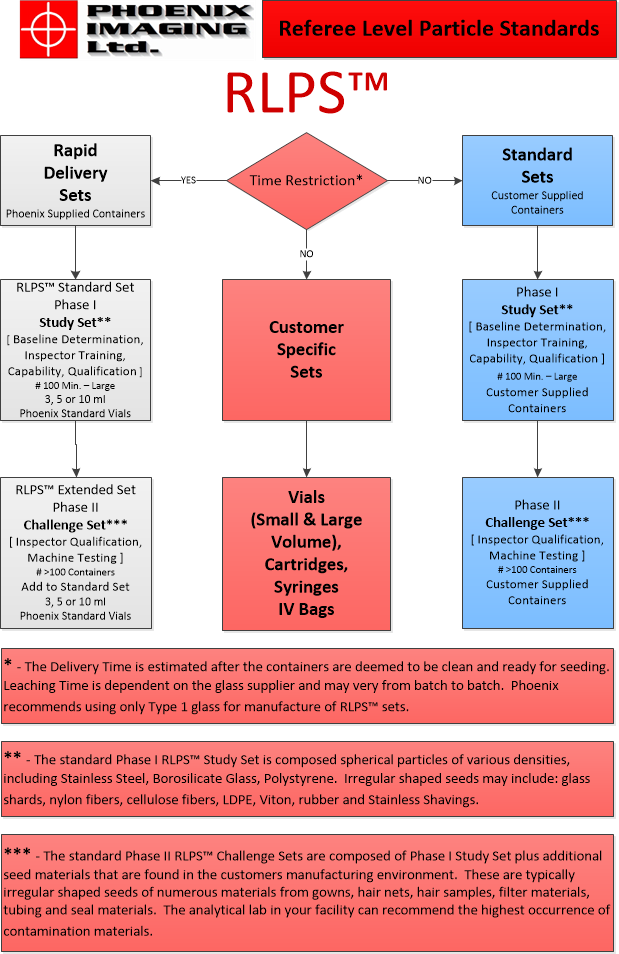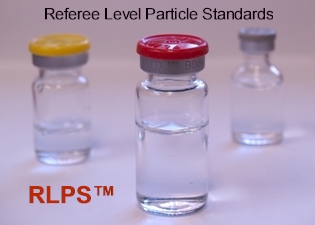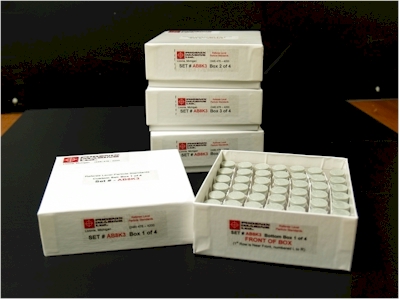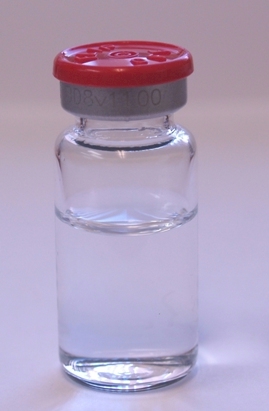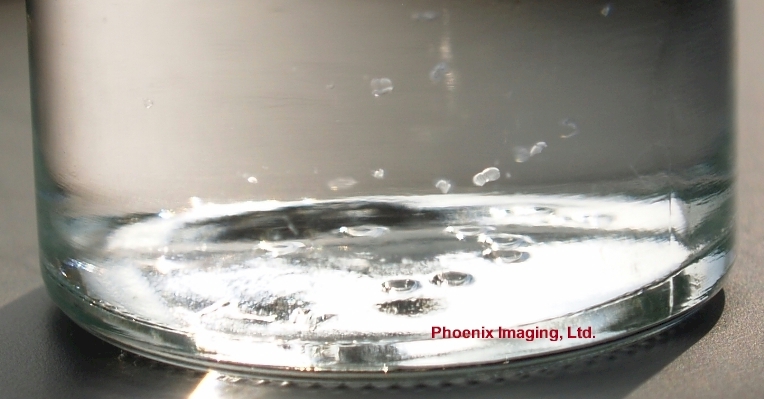Referee Level Particle Standard (RLPS™) Sets
for Training and Certification of Manual Inspection and Calibration Sets for Validation of Automated Inspection Equipment.
Phoenix Imaging Referee Level Particle Standard (RLPS™) sets are available in several container quantities, sizes and levels. The RLPS™ set is available in custom and standard container numbers. The Standard (Phase I) kit contains 100 containers, 36 containers are seeded with known size / shape particles and 64 “Clean” containers. This Standard Set can be expanded to include additional containers of with a larger selection of contamination materials and sizes. It is not uncommon to have a RLPS™ set of 150 or more containers. The Phase I Standard Set is used primarily to train and determine the capability of the inspection team members to recognize particle size and shape. The Phase I Standard Set is very useful for Baseline Determination as referenced in the methods of Julius Knapp. The Phase I study will aid your organization in selection of inspection team members that will become the basis of the Baseline Determination. It contains a number of spherical particles ranging in sizes from small (~30 µm diameter) to very large (>500 µm diameter) of various density materials. Using the Phase I Standards will allow the customer to generate a Human Response Curve (aka HMC is the Probability of Detection vs. Particle Size at a specific light intensity in the inspection volume) so that the 70.7% Rejection Probability size can be determined for products of similar packaging and optical density. It should be noted that the light intensity is assumed to be constant in the inspection volume. If the light intensity is not consistent in the inspection volume, then the characteristic line that is generated in the HMC will become broadened and the minimum particle size will become less defined.
The Extension of the Phase I Standard Set into an Extended Set (commonly referred to as a Phase II Challenge Set) is accomplished by adding more containers with irregular shaped particles that are at or above the 70.7% Probability of Rejection size determined by the Phase I study. As an option the customer may purchase the RLPS™ Extended (Phase II) set without the purchase of the RLPS™ Standard Phase I set if desired. The irregular shaped contaminating particles are typically composed of materials found in the manufacturing environment of the customers facility. Often the particles include glass if the containers are glass or plastic in the containers, are plastic. More often the particles are other forms of contamination such as fibers and seal materials found in the process area.
The Referee Level Particle Standard (RLPS™) Phase I set is available for the training of inspectors and determination of the human visual inspector baseline using the MIB-100. The Basic RLPS™ Phase I set provides samples seeded with a single stainless steel particle of a specific size. The samples are produced using customer specified containers, stoppers, seals and fill level. The standard particle sizes range from 50µm to 900µm in diameter. This sample set is designed to train and evaluate the detection capability of individual inspectors. Following the training mode, the RLPS™ set can be used to generate a calibration curve. The calibration curve relates particle size to particle rejection probability. The use of the calibration curve provides an economically effective alternative to the re-determination of the rejection probability of each particle in the sampled container set. Without the calibration curve the rejection probability of each container in the sampled container set must be independently generated. This would entail multiple inspection of each container in the sample set to achieve 0.95% confidence results.
The RLPS™ – Phase I Standard set includes stainless steel and glass spheres ranging in size from 40µm to 1000µm. The RLPS™ Phase II Extended set also includes fibers, floaters and glass shards as sample contaminating particles for training purposes. The standard solution used in the fabrication of the set is WFI and is therefore clear in appearance. The test samples are prepared with particles of known sizes that are NIST traceable. The RLPS™ Extended set is not required but is the most popular set and is recommended for most customers. Additional containers may be purchased with a wide selection of contaminating particle upon request. We can also change the Opacity (Optical clarity or turbidity NTU 0 – 50) of the samples to any set.
Since the Referee Level Particle Standards are used for training and inspection qualifications the set must meet the strictest requirements for clarity and particle size determination. The containers provided by the customer are requested to be cleaned and depyrogenated as if they were to be used in production. We rewash the containers and stoppers in the preparation process. The containers are examined very carefully to ensure that they free of any contamination prior to the seeding operation. We have found that container quality has a considerable influence on the preparation time. An important part of the preparation is to ensure that all of the trace elements have been removed from the container interior walls. Each container is sealed with a closure that is laser matched with unique Lot/Serial number that identifies the actual content of the container. The customer is supplied with Certificate of Analysis (COA) that describes the container, its contents and the seed particle material and seed particle size (see sample sheet below).
Each RLPS™ set is seeded with particles that are populated from very small (35-50 µm) to very large (800 – 1100 µm). The largest percentage of particles is concentrated is near the visible limit of human inspectors at 500 foot-candles of illumination for container of a particular size. Small containers (1 ml) shift the center of the particle distribution toward small particle sizes (Level I) and larger containers (500 – 1000 ml) shift the center of the particle distribution to large particle sizes (Level VI). The container material also has an influence on which Level particle standards should be used for seeding. Each individual seed sample is examined for shape and measured precisely to ±1 µm, it is then photographed for inclusion into your records prior to seeding. You are supplied with all documentation and photographs on a CD-ROM included with samples.
Note: The RLPS Standard Phase I sets include stainless steel, borosilicate glass and polystyrene spherical particles. Spherical particles are required so that particle orientation will not influence the perceived size of particle when determining the efficiency of each operator in the human baseline determination study.
The RLPS™ – standard set includes stainless steel, glass and polystyrene spheres ranging in size from 40µm to 1000µm. The RLPS™ standard set also includes fibers, floaters and glass shards as sample contaminating particles for training purposes. The standard solution used in the fabrication of the set is WFI and is therefore clear in appearance. The test samples are prepared with particles of known sizes that are NIST traceable. The RLPS™ Extended set is not required but is the most popular set and is recommended for most customers. Additional containers may be purchased with a wide selection of contaminating particle upon request. We can also add discoloration or turbidity samples to the set.
Since the Referee Level Particle Standards are used for training and inspection qualifications the set must meet the strictest requirements for clarity and particle size determination. The containers provided by the customer are requested to be cleaned and depyrogenated as if they were to be used in production. We rewash the containers and stoppers in the preparation process. The containers are examined very carefully to ensure that they free of any contamination prior to the seeding operation. We have found that container quality has a considerable influence on the preparation time. An important part of the preparation is to ensure that all of the trace elements have been removed from the container interior walls. Each container is sealed with a closure that is laser matched with unique Lot/Serial number that identifies the actual content of the container. The customer is supplied with Certificate of Analysis (COA) that describes the container, its contents and the seed particle material and seed particle size (see sample sheet below).
Each RLPS™ set is seeded with particles that are populated from very small (40-50 µm) to very large (800 – 1100 µm). The largest percentage of particles is concentrated is near the visible limit of human inspectors at 500 foot-candles of illumination for container of a particular size. Small containers (1 ml) shift the center of the particle distribution toward small particle sizes (Level I) and larger containers (500 – 1000 ml) shift the center of the particle distribution to large particle sizes (Level VI). The container material also has an influence on which Level particle standards should be used for seeding. Each individual seed sample is examined for shape and measured precisely to ±1 µm, it is then photographed for inclusion into your records prior to seeding. You are supplied with all documentation and photographs on a CD-ROM included with samples.
Note: The RLPS sets only include stainless steel and borosilicate glass spherical particles. Spherical particles are required so that particle orientation will not influence the perceived size of particle when determining the efficiency of each operator in the human baseline determination study.
Note: The container can be Laser marked on the aluminum closure with just the Human Readable information (Lot and Serial Number), 2D Matrix Codes (Lot and Serial Number) or marked with both the Human Readable and 2D Matrix. If the container is a syringe, conical, or IV Bag they are supplied with a Thermal Print Label and the same information is selectable for imprint.
Referee Level Particle Standards – Standard Phase I Set Includes:
100 vials total (35 seeded, 65 clean)
Stainless Steel Spheres sizes range from 50µm – 800µm
Glass Spheres (transparent) sizes range from 70µm – 1100µm
Glass Shards (transparent) sizes range from 250µm – 1,500µm
Nylon Fibers (Black) sizes 1, 2, & 3 mm (Other sizes upon request)
LDPE (white irregular) sizes 200 – 300 µm proximal length
Polystyrene (Translucent spherical) sizes 100 – 500 µm diameters
Referee Level Particle Standards – Extended Phase II Set (aka Challenge Set) Includes:
150 vials total (50 seeded, 100 clean)
Stainless Steel Spheres sizes range from 50µm – 800µm
Glass Spheres (transparent) sizes range from 70µm – 1100µm
Glass Shards (transparent) sizes range from 100µm – 1,500µm
Nylon Fibers (Black) sizes 250µm – 3000µm, (Other sizes upon request)
LDPE (white irregular) sizes 200 – 300 µm proximal length
Polystyrene (Translucent spherical) sizes 100 – 500 µm diameters
Aluminum Fragment (irregular) sizes 200µm – 1 mm proximal length
Stainless Steel Fragment (irregular) sizes 200µm – 1 mm proximal length
Hair (Black or Blonde) filament size 300µm – 1 mm proximal lengt
Multiple Seed in one container
Cosmetic Defects – Discoloration, Over / Under Fill, Crimp, Rubber Stopper, Cracked Containers
Turbidity Defects, Granulation Defects, and Flocculants
Referee Level Particle Standards – Custom Samples:
The Standard or Extended Sets may be customized with Additional Samples requested by the customer.
Typical additional seeding materials include: gown material, teflon, LDPE, Viton, aluminum shards, cellulose fibers, hair, Lamina(see image below right), etc…. The customer may also request that the containers have altered viscosity, color or turbidity(see sample image below left). We will attempt to manufacture these samples to closely match examples provided by the customer or of our own design. The cost of the Custom samples is dependent on the seeding material, the composition of the solution and the container size. Please contact the office for additional information.
The RLPS™ sets are provided with a Certificate of Analysis of each containers content and photographs of the actual seeds used in the samples. The report includes the actual seed sizes as measured with an NIST traceable laser micrometer translation stage with special high power microscope and image processing system. All containers are laser marked on the aluminum closure (vials) with a indelible 2-D code and equivalent human readable code. All documentation is provided in written form (with exception of the photographs) and on a CDROM or DVD. A example of a Certification of Analysis and for additional information about the subject follow the link below,
